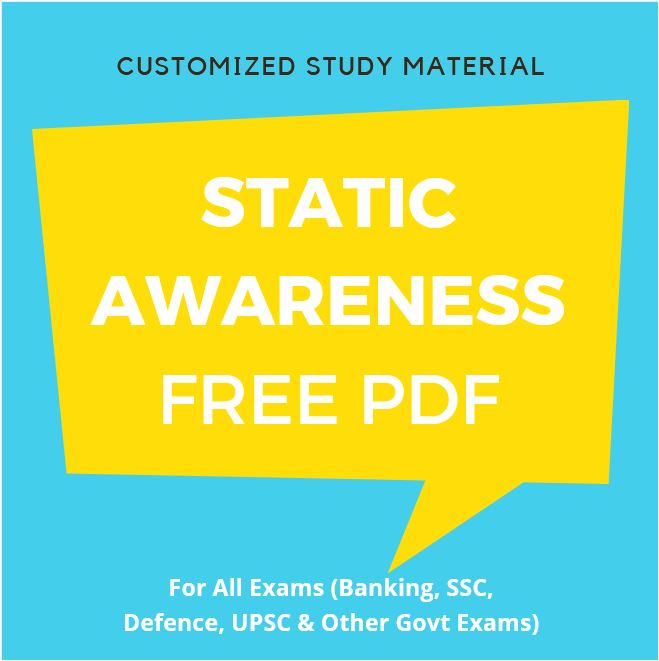Banking Awareness is considered to be the high scoring section in any competitive exam. It includes two main portions, current affairs GK and static GK. In this article, we will discuss some really important Banking Awareness topics that are covered in almost all competitive exams. Also, you can download the PDF of lists of different Banking Awareness topics.
In Banking Section, the questions are asked from following topics: History of Banking, banking terms, Marketing of Banking Products, Functions of Banks, Banks and their taglines, schemes, committees related to banking, headquarters of bank, some Banking news related, apps launched by banks, new schemes etc.
In a series of sharing useful study material for upcoming banking exams. Here, we are providing Banking Awareness notes for all banking Exams (IBPS, SBI & Other Banking Exams).
Banking Awareness Study Notes on Structure & Functions of RBI
The Reserve Bank of India (RBI) is India’s central bank, also known as the banker’s bank. The RBI controls monetary and other banking policies of the Indian government. The Reserve Bank of India (RBI) was established on April 1, 1935, in accordance with the Reserve Bank of India Act, 1934. The Reserve Bank is permanently situated in Mumbai since 1937.
Functions of RBI
Following is the list of important functions of Reserve Bank Of India
Issuance of Currency
Under sec 22 of RBI Act,1934, RBI has the sole agency/authority in India to issue currency notes (called Bank Notes) under signatures of Governor of RBI, except One rupee notes which are issued by the Ministry of Finance and it bears the signatures of Finance Secretary.
RBI has a separate issue department which is responsible for issue of currency notes. Originally, the assets of the Issue Department were to consist of not less than two-fifths of gold coin, gold bullion or sterling securities provided the amount of gold was not less than Rs. 40 crores in value. The remaining three-fifths of the assets might be held in rupee coins, Government of India rupee securities, eligible bills of exchange and promissory notes payable in India.
Since 1957, the Reserve Bank of India is required to maintain gold and foreign exchange reserves of Rs. 200 crores, of which at least Rs. 115 crores should be in gold. The system as it exists today is known as the Minimum Reserve System.
Coins are minted by Govt. of India at Mumbai,Kolkata,Hyderabad,NOIDA and currency notes press of Govt of India are at Currency note press (Nashik) and Bank Note press (Dewas).
Currency notes press of RBI are at Mysore (Karnataka) and Salboni (West Bengal).
Banker to Government
Under sec 20 (for Central govt) and sec 21-A (for state govt) of RBI Act 1934, RBI transacts govt business and manages public debt.
Whenever there is a temporary mismatches between receipts and expenditure of State and Central government RBI provides the necessary cash flow this phenomenon is known as WAYS AND MEANS ADVANCES. A state Government can withdraw an overdraft for maximum of 14 days consecutively whereas Central Government can withdraw an overdraft for maximum of 10 days consecutively.Interest rate is linked to Repo rate.
RBI represents the Government of India as the member of the IMF and the World Bank.
Banker to other Banks
The RBI being an apex monitory institution has obligatory powers to guide, help and direct other commercial banks in the country. The RBI can control the volumes of banks reserves and allow other banks to create credit in that proportion. Every commercial bank has to maintain a part of their reserves (as Cash Reserve Ratio) with RBI.
Controller and Supervisor of Banks
The RBI has been assigned the role of controlling and supervising the bank system in India. The RBI is responsible for controlling the overall operations of all banks in India. These banks may be:
- Public sector banks
- Private sector banks
- Foreign banks
- Co-operative banks, or
- Regional rural banks
The supervisory role of RBI such as Issue of Bank Licence, Know Your Customer (KYC) Norms, Corporate Governance, Audit and inspection etc.
Formulator of Monetary Policy
The RBI formulates monetary policy twice a year. It reviews the policy every quarter as well. The main objectives of monitoring monetary policy are:
- Inflation control
- Control on bank credit
- Interest rate control
The tools used for implementation of the objectives of monetary policy are:
- Cash Reserve Ratio (CRR) and Statutory Liquidity Ratio (SLR),
- Open market operations
- Different Rates such as Repo rate, Reverse Repo rate, Marginal and Standing Facility (MSF), Bank rate and Market Stabilisation Scheme.
Lender of Last Resort
The commercial banks approach the Reserve Bank in times of emergency to tide over financial difficulties, and the Reserve bank comes to their rescue though it might charge a higher rate of interest.
Custodian of Foreign Exchange Reserve
The Reserve Bank is the custodian of India’s foreign exchange reserves. It maintains and stabilises the external value of the rupee, administers exchange controls and other restrictions imposed by the government, and manages the foreign exchange reserves. The Reserve Bank fixes the selling and buying rates of foreign currencies. All Indian remittances to foreign countries and foreign remittances to India are made through the Reserve Bank.
Regulator and Supervisor of Payment and Settlement system
Payment and settlement systems play an important role in improving overall economic efficiency. The Payment and Settlement Systems Act of 2007 (PSS Act) gives the Reserve Bank oversight authority, including regulation and supervision, for the payment and settlement systems in the country.
In this role, we focus on the development and functioning of safe, secure and efficient payment and settlement mechanisms.
Two payment systems, National Electronic Fund Transfer (NEFT) and Real Time Gross Settlement (RTGS) allow individuals, companies and firms to transfer funds from one bank to another within the country.
Developmental Role
This is one of the most critical role RBI plays in building country’s financial structure. Key tools in this effort include Priority sector lending such as Agriculture, Micro and Small Enterprise (MSE), housing and education. RBI work towards strengthening and supporting small local banks and encourage banks to open branches in rural areas to include large section of society in banking net.













